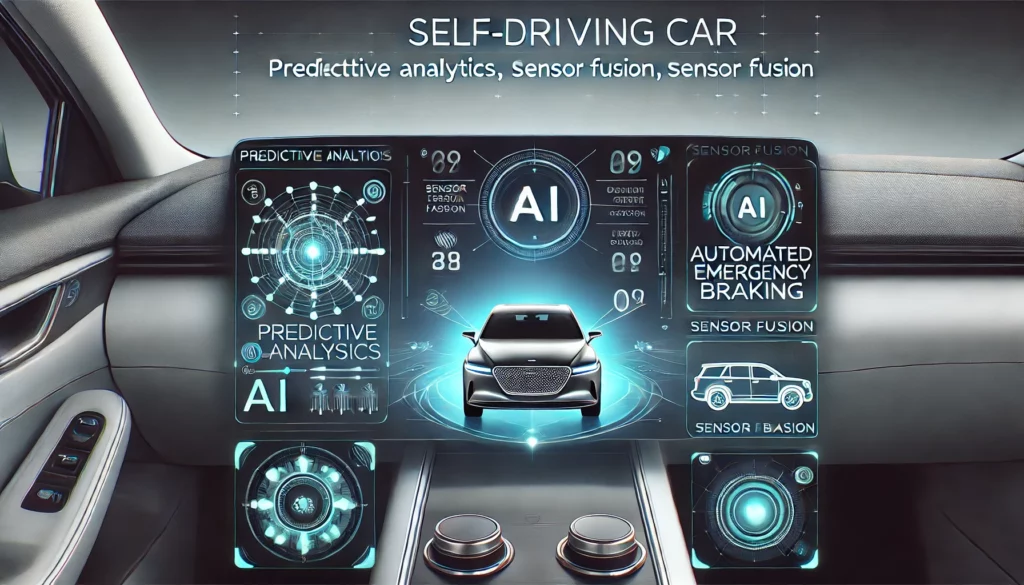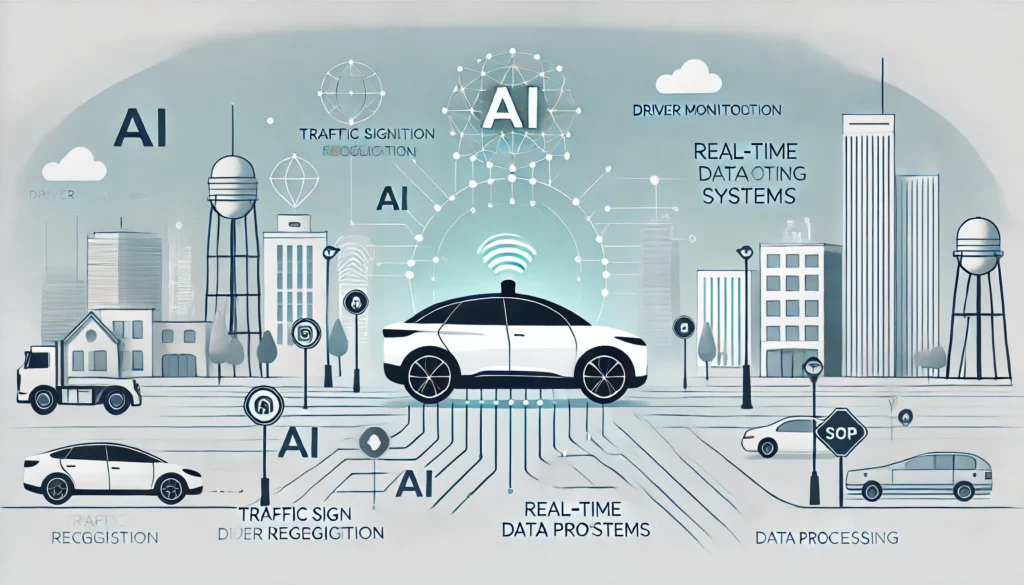Introduction
The advent of autonomous vehicles marks a significant milestone in the evolution of transportation. These self-driving cars promise not only to revolutionize how we travel but also to enhance road safety dramatically. At the heart of this transformation lies artificial intelligence (AI), which drives the sophisticated systems ensuring these vehicles operate safely. This article explores the essential AI-driven safety features in autonomous vehicles, highlighting their importance and future prospects.
The Evolution of Autonomous Vehicle Technology
Autonomous vehicles have come a long way since their early conceptual stages. The journey began with DARPA’s Grand Challenges in the early 2000s, which spurred significant advancements in self-driving technology (Udacity). Over the past two decades, major companies like Google (Waymo), Tesla, and traditional automakers have invested heavily in developing and refining autonomous vehicles (Udacity). Today, these vehicles are equipped with advanced AI systems capable of navigating complex environments and making real-time decisions to ensure safety on the road.

Core Safety Features Enabled by AI
Advanced Driver Assistance Systems (ADAS) ADAS encompasses a range of technologies designed to assist drivers and enhance vehicle safety. These systems include lane-keeping assist, adaptive cruise control, and automated parking. By leveraging AI, ADAS can predict and react to potential hazards, reducing the likelihood of accidents (Stanford HAI).

Sensor Fusion Technology Sensor fusion is a critical technology that combines data from various sensors, such as LIDAR, radar, and cameras, to create a comprehensive understanding of the vehicle’s surroundings. AI algorithms process this data to make informed decisions about navigation and collision avoidance (Frontiers) (Emerj Artificial Intelligence Research).
Real-Time Data Processing Autonomous vehicles must process vast amounts of data in real-time to ensure safe operation. AI plays a crucial role in analyzing sensor data, identifying potential threats, and executing appropriate responses within milliseconds (Stanford HAI) (Udacity).
Predictive Analytics Predictive analytics involves using AI to forecast potential hazards based on historical data and real-time inputs. This capability allows autonomous vehicles to anticipate and mitigate risks before they lead to dangerous situations (Frontiers).
AI-Driven Innovations Enhancing Road Safety
Collision Avoidance Systems AI-powered collision avoidance systems detect imminent collisions and take necessary actions to prevent them. These systems use data from sensors to identify obstacles and calculate the best course of action, such as braking or steering away from danger (Frontiers) (Emerj Artificial Intelligence Research).
Automated Emergency Braking Automated emergency braking (AEB) systems are designed to apply brakes automatically when a potential collision is detected. AI algorithms analyze the distance and speed of approaching objects, ensuring timely intervention to avoid accidents (Frontiers) (Emerj Artificial Intelligence Research).
Driver Monitoring Systems To ensure human drivers remain alert and responsive, driver monitoring systems use AI to track eye movements, head position, and other indicators of attentiveness. If signs of distraction or drowsiness are detected, the system can issue warnings or take corrective actions (Udacity).
Traffic Sign Recognition AI enables autonomous vehicles to read and interpret traffic signs accurately. This capability ensures that self-driving cars comply with road regulations and adapt to changing traffic conditions seamlessly (Emerj Artificial Intelligence Research).
Section 4: Real-World Applications and Case Studies
Autonomous vehicles are no longer a futuristic concept; they are already being tested and used in various applications. Companies like Waymo and Tesla have made significant strides in deploying self-driving cars on public roads (Emerj Artificial Intelligence Research). For instance, Waymo’s extensive testing in real-world environments has demonstrated the effectiveness of AI-driven safety features in preventing accidents and enhancing road security (Emerj Artificial Intelligence Research).
Section 5: Challenges and Future Prospects
Technical Challenges Despite the advancements, autonomous vehicles face technical challenges, such as sensor limitations, adverse weather conditions, and data accuracy. Addressing these issues is crucial for ensuring reliable and safe operation (Stanford HAI) (Frontiers).
Regulatory and Ethical Considerations The regulatory landscape for autonomous vehicles is still evolving. Establishing clear standards for safety, liability, and data privacy is essential for the widespread adoption of self-driving cars. Additionally, ethical considerations, such as decision-making in unavoidable accident scenarios, need careful attention (ITU).
Future Innovations The future of autonomous vehicles holds promising advancements in AI and self-driving technology. Innovations like improved sensor fusion, more robust AI algorithms, and enhanced predictive analytics are expected to further enhance road safety (Frontiers) (Emerj Artificial Intelligence Research).
Public Perception and Adoption Gaining public trust is crucial for the success of autonomous vehicles. Companies must address concerns about safety and reliability through transparency, rigorous testing, and effective communication (ITU).
Conclusion
AI-driven safety features are revolutionizing road security by making autonomous vehicles safer and more reliable. From advanced driver assistance systems to predictive analytics, AI plays a central role in enhancing the safety of self-driving cars. As technology continues to evolve, the future of autonomous vehicles looks promising, with the potential to significantly reduce accidents and transform transportation.
Frequently Asked Questions (FAQs)
Q1: What are the main safety benefits of AI in self-driving cars?
A1: AI enhances safety in self-driving cars through several key features:
- Advanced Driver Assistance Systems (ADAS): Helps with lane-keeping, adaptive cruise control, and automated parking.
- Collision Avoidance Systems: Detects and prevents potential collisions using real-time data from various sensors.
- Automated Emergency Braking (AEB): Automatically applies brakes to avoid accidents.
- Driver Monitoring Systems: Ensures human drivers remain alert and responsive by tracking eye movements and head position.
Q2: How do autonomous vehicles handle ethical dilemmas on the road?
A2: Handling ethical dilemmas, such as deciding between avoiding an accident with pedestrians or protecting vehicle occupants, is a significant challenge. AI systems are designed to follow pre-set ethical guidelines and make decisions based on the best available data. Public trust and transparency in how these decisions are made are crucial for the acceptance of autonomous vehicles (ITU) (Frontiers).
Q3: What are the challenges faced by autonomous vehicles in adverse weather conditions?
A3: Adverse weather conditions like heavy rain, snow, or fog can impair the sensors used by autonomous vehicles. AI systems must be robust enough to handle reduced visibility and changes in road conditions. Ongoing research aims to improve sensor technology and AI algorithms to enhance performance under such conditions (Stanford HAI) (Frontiers).
Q4: What regulations are in place for the deployment of self-driving cars?
A4: Regulations for self-driving cars vary by region and are still evolving. Key areas of focus include safety standards, liability in case of accidents, data privacy, and cybersecurity. Governments and regulatory bodies are working to establish comprehensive frameworks to ensure the safe deployment of autonomous vehicles (ITU).